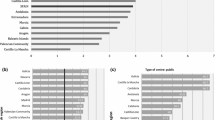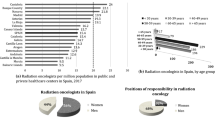Abstract
Purpose
The purpose of this study was to evaluate the present status of radiotherapy infrastructure and human resources in Switzerland and compute projections for 2020.
Materials and methods
The European Society of Therapeutic Radiation Oncology “Quantification of Radiation Therapy Infrastructure and Staffing” guidelines (ESTRO-QUARTS) and those of the International Atomic Energy Agency (IAEA) were applied to estimate the requirements for teleradiotherapy (TRT) units, radiation oncologists (RO), medical physicists (MP) and radiotherapy technologists (RTT). The databases used for computation of the present gap and additional requirements are (a) Global Cancer Incidence, Mortality and Prevalence (GLOBOCAN) for cancer incidence (b) the Directory of Radiotherapy Centres (DIRAC) of the IAEA for existing TRT units (c) human resources from the recent ESTRO “Health Economics in Radiation Oncology” (HERO) survey and (d) radiotherapy utilization (RTU) rates for each tumour site, published by the Ingham Institute for Applied Medical Research (IIAMR).
Results
In 2015, 30,999 of 45,903 cancer patients would have required radiotherapy. By 2020, this will have increased to 34,041 of 50,427 cancer patients. Switzerland presently has an adequate number of TRTs, but a deficit of 57 ROs, 14 MPs and 36 RTTs. By 2020, an additional 7 TRTs, 72 ROs, 22 MPs and 66 RTTs will be required. In addition, a realistic dynamic model for calculation of staff requirements due to anticipated changes in future radiotherapy practices has been proposed. This model could be tailor-made and individualized for any radiotherapy centre.
Conclusion
A 9.8 % increase in radiotherapy requirements is expected for cancer patients over the next 5 years. The present study should assist the stakeholders and health planners in designing an appropriate strategy for meeting future radiotherapy needs for Switzerland.
Zusammenfassung
Ziel
Ziel dieser Studie war es, den aktuellen Stand der Infrastruktur und Personalausstattung der Strahlentherapie in der Schweiz zu bewerten und Prognosen für das Jahr 2020 zu erstellen.
Material
Die ESTRO-QUARTS- und IAEA-Richtlinien wurden angewandt, um den Bedarf für Teletherapie-(TRT-)Einheiten, Radioonkologen (RO), Medizinphysiker (MP) und Medizinisch-technische Radiologieassistenten (RTT) abzuschätzen. Die Datenbanken, die für die Errechnung der gegenwärtigen Lücke und die zusätzlichen Anforderungen verwendet wurden, sind (a) GLOBOCAN (Global Cancer Incidence, Mortality and Prevalence) für die Krebsinzidenz, (b) das Verzeichnis der Bestrahlungszentren (DIRAC, Directory of Radiotherapy Centres) der IAEA (International Atomic Energy Agency) für bestehende TRT-Einheiten, (c) die neueste ESTRO-HERO-Studie (European Society of Therapeutic Radiation Oncology – Health Economics in Radiation Oncology) für die Personalausstattung und (d) Daten vom Ingham Institute for Applied Medical Research (IIAMR) über den Grad der Bestrahlungstherapieauslastung (RTU) für jede Krebsart.
Ergebnisse
Im Jahr 2015 hätten 30.999 von 45.903 Krebspatienten eine Bestrahlung benötigt. Bis 2020 wird diese Zahl auf 34.041 von 50.427 Krebspatienten steigen. Die Schweiz verfügt zwar momentan über eine ausreichende Anzahl an TRT-Einheiten, weist aber einen Mangel von 57 ROs, 14 MPs und 36 RTTs auf. Bis 2020 werden zusätzlich 7 TRT-Einheiten, 72 ROs, 22 MPs und 66 RTTs benötigt. Zusätzlich wurde ein wirklichkeitsnahes, dynamisches Modell vorgeschlagen, um den Bedarf an Personal aufgrund von künftig zu erwartenden Änderungen in den Bestrahlungstherapietechniken zu errechnen. Dieses Modell könnte auf die individuellen Bedürfnisse eines beliebigen Bestrahlungszentrums angepasst werden.
Schlussfolgerung
Der Bedarf an Bestrahlungstherapie für Krebspatienten wird in den nächsten 5 Jahren um 9,8 % steigen. Diese Studie soll Stakeholder und Gesundheitsplaner dabei unterstützen, eine entsprechende Strategie zu entwickeln, um künftigen Anforderungen in der Strahlentherapie in der Schweiz gerecht zu werden.
Fazit
Der Bedarf an Bestrahlungstherapie für Krebspatienten wird in den nächsten 5‑Jahren um 9,8 % steigen. Diese Studie soll Stakeholder und Gesundheitsplaner dabei unterstützen, eine entsprechende Strategie zu entwickeln, um künftigen Anforderungen in der Strahlentherapie in der Schweiz gerecht zu werden.



Similar content being viewed by others
References
http://www.euro.who.int/en/data-and-evidence/european-health-report/european-health-report-2012. Accessed 12 Dec 2015
http://www.bfs.admin.ch/bfs/portal/en/index/news/publikationen.html?publicationID=6857. Accessed 12 Dec 2015
Rapiti E, Guarnori S, Pastoors B, Miralbell R, Usel M (2014) Planning for the future: cancer incidence projections in Switzerland up to 2019. BMC Public Health 14:102
Slotman BJ, Cottier B, Bentzen SM, Heeren G, Lievens Y, van den Bogaert W (2005) Overview of national guidelines for infrastructure and staffing of radiotherapy. ESTRO-QUARTS: work package 1. Radiother Oncol 75:349–354
Atun R, Jaffray DA, Barton MB, Bray F, Baumann M, Vikram B et al (2015) Expanding global access to radiotherapy. Lancet Oncol 16:1153–1186
http://globocan.iarc.fr. Accessed 10 Dec 2015
http://www-naweb.iaea.org/nahu/dirac/login.asp. Accessed 10 Dec 2015
Lievens Y, Defourny N, Coffey M, Borras JM, Dunscombe P, Slotman B et al (2014) Radiotherapy staffing in the European countries: final results from the ESTRO-HERO survey. Radiother Oncol 112:178–186
http://www-pub.iaea.org/mtcd/publications/pdf/pub1462_web.pdf. Accessed 10 Dec 2015
http://inghaminstitute.org.au/sites/default/files/RTU_Review_Final_v3_02042013.pdf. Accessed 10 Dec 2015
Delaney G, Jacob S, Featherstone C, Barton M (2005) The role of radiotherapy in cancer treatment: estimating optimal utilization from a review of evidence-based clinical guidelines. Cancer 104:1129–1137
Datta NR, Samiei M, Bodis S (2014) Radiotherapy infrastructure and human resources in Europe – present status and its implications for 2020. Eur J Cancer 50:2735–2743
Datta NR, Samiei M, Bodis S (2014) Radiation therapy infrastructure and human resources in low- and middle-income countries: present status and projections for 2020. In reply to Sharma et al. Int J Radiat Oncol Biol Phys 90:971–972
Amendola BE, Amendola M, Perez N, Iglesias A, Wu X (2013) Volumetric-modulated arc therapy with RapidArc®: An evaluation of treatment delivery efficiency. Rep Pract Oncol Radiother 18:383–386
Roa DE, Schiffner DC, Zhang J, Dietrich SN, Kuo JV, Wong J et al (2012) The use of RapidArc volumetric-modulated arc therapy to deliver stereotactic radiosurgery and stereotactic body radiotherapy to intracranial and extracranial targets. Med Dosim 37:257–264
Bonastre J, Noel E, Chevalier J, Gerard JP, Lefkopoulos D, Bourhis J et al (2007) Implications of learning effects for hospital costs of new health technologies: The case of intensity modulated radiation therapy. Int J Technol Assess Health Care 23:248–254
Thomas SJ, Vinall A, Poynter A, Routsis D (2010) A multicentre timing study of intensity-modulated radiotherapy planning and delivery. Clin Oncol (R Coll Radiol) 22:658–665
Budach W, Bolke E, Fietkau R, Buchali A, Wendt TG, Popp W et al (2011) Evaluation of time, attendance of medical staff, and resources during radiotherapy for head and neck cancer patients: The DEGRO-QUIRO trial. Strahlenther Onkol 187:449–460
Fietkau R, Budach W, Zamboglou N, Thiel HJ, Sack H, Popp W (2012) Time management in radiation oncology: development and evaluation of a modular system based on the example of rectal cancer treatment. The DEGRO-QUIRO trial. Strahlenther Onkol 188:5–11
Blank E, Willich N, Fietkau R, Popp W, Schaller-Steiner J, Sack H et al (2012) Evaluation of time, attendance of medical staff, and resources during radiotherapy for breast cancer patients. The DEGRO-QUIRO trial. Strahlenther Onkol 188:113–119
Zabel-du BA, Milker-Zabel S, Bruns F, Christiansen H, Ernst I, Willich N et al (2014) Evaluation of time, attendance of medical staff and resources for radiotherapy in pediatric and adolescent patients. The DEGRO-QUIRO trial. Strahlenther Onkol 190:582–590
Keilholz L, Willner J, Thiel HJ, Zamboglou N, Sack H, Popp W (2014) Time management in radiation oncology: evaluation of time, attendance of medical staff, and resources during radiotherapy for prostate cancer: The DEGRO-QUIRO trial. Strahlenther Onkol 190:17–25
Vorwerk H, Zink K, Schiller R, Budach V, Bohmer D, Kampfer S et al (2014) Protection of quality and innovation in radiation oncology: The prospective multicenter trial the German Society of Radiation Oncology (DEGRO-QUIRO study). Evaluation of time, attendance of medical staff, and resources during radiotherapy with IMRT. Strahlenther Onkol 190:433–443
Hwee J, Louie AV, Gaede S, Bauman G, D’Souza D, Sexton T et al (2011) Technology assessment of automated atlas based segmentation in prostate bed contouring. Radiat Oncol 6:110
Gaede S, Olsthoorn J, Louie AV, Palma D, Yu E, Yaremko B et al (2011) An evaluation of an automated 4D-CT contour propagation tool to define an internal gross tumour volume for lung cancer radiotherapy. Radiother Oncol 101:322–328
Grau C, Defourny N, Malicki J, Dunscombe P, Borras JM, Coffey M et al (2014) Radiotherapy equipment and departments in the European countries: final results from the ESTRO-HERO survey. Radiother Oncol 112:155–164
Smith BD, Smith GL, Hurria A, Hortobagyi GN, Buchholz TA (2009) Future of cancer incidence in the United States: Burdens upon an aging, changing nation. J Clin Oncol 27:2758–2765
http://www.nicer.org/assets/files/publications/not-peer-reviewed/skb_04-2014_prevalence_cancer_survivors_ch.pdf. Accessed 6 Dec 2015
Rosenblatt E, Izewska J, Anacak Y, Pynda Y, Scalliet P, Boniol M et al (2013) Radiotherapy capacity in European countries: An analysis of the Directory of Radiotherapy Centres (DIRAC) database. Lancet Oncol 14:79–86
Bentzen SM, Heeren G, Cottier B, Slotman B, Glimelius B, Lievens Y et al (2005) Towards evidence-based guidelines for radiotherapy infrastructure and staffing needs in Europe: The ESTRO QUARTS project. Radiother Oncol 75:355–365
Datta NR, Heuser M, Samiei M, Shah R, Lutters G, Bodis S (2015) Teleradiotherapy network: Applications and feasibility for providing cost-effective comprehensive radiotherapy care in low- and middle-income group countries for cancer patients. Telemed J E Health 21:523–532
Datta NR, Heuser M, Bodis S (2016) A roadmap and cost implications of establishing comprehensive cancer care using a teleradiotherapy network in a group of sub-Saharan African countries with no access to radiotherapy. Int J Radiat Oncol Biol Phys 95:1334–43
http://www.nicer.org/en/statistics-atlas/. Accessed 12 Dec 2015
Author information
Authors and Affiliations
Corresponding author
Ethics declarations
Conflict of interest
N.R. Datta, S. Khan, D. Marder, D. Zwahlen and S. Bodis state that they have no competing interest.
Ethical standards
This article does not contain any studies with human participants or animals performed by any of the authors.
Additional information
Presented at the 19th Annual Meeting of the Scientific Association of Swiss Radiation Oncology (SASRO), Basel, 11–13 June 2015.
Rights and permissions
About this article
Cite this article
Datta, N.R., Khan, S., Marder, D. et al. Radiotherapy infrastructure and human resources in Switzerland. Strahlenther Onkol 192, 599–608 (2016). https://doi.org/10.1007/s00066-016-1022-8
Received:
Accepted:
Published:
Issue Date:
DOI: https://doi.org/10.1007/s00066-016-1022-8




